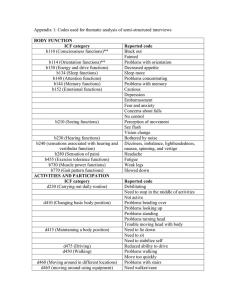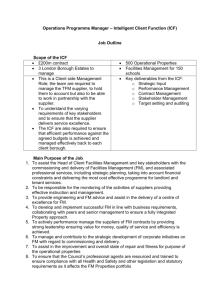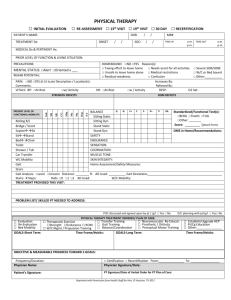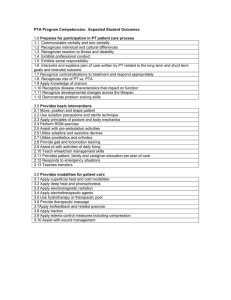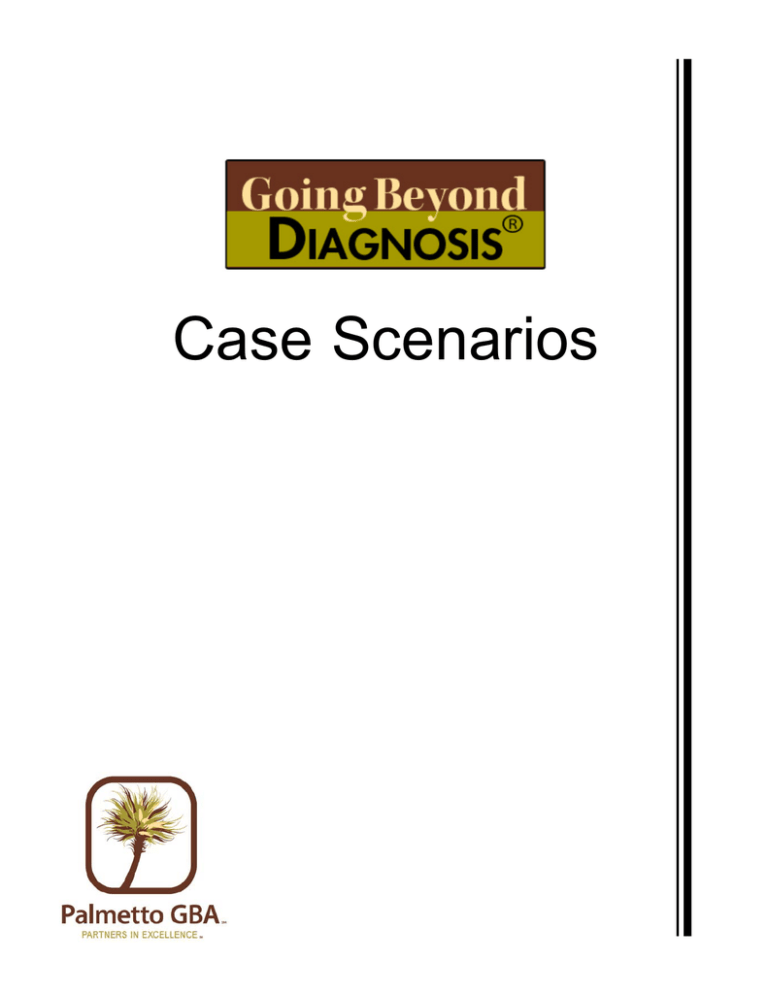
Case Scenarios
Case
Scenario
CS #01.IRF.2008
CG is a 64 year old right-handed beneficiary who at baseline is very athletic and independent in activities
of daily living. She lives with her husband in a two-story private residence - with three steps to enter and
ten stairs to access the second story. CG presented to a hospital emergency department (ED) with a
two-week history of mental status changes, decline in function, and right sided weakness. A CT scan of
her brain revealed a large midline mass with significant edema. A subsequent MRI revealed a diffuse,
enhancing midline lesion of the posterior corpus callosum extending into both parietal lobes and to the
anterior portion of the third ventricle - satellite lesions were noted. Stereotactic biopsy of the brain tumor
was positive for glioblastoma multiforme. CG was started on Decadron® to help control brain swelling,
whole brain radiation and chemotherapy with Temadar® to help shrink the tumor, and received both
physical and occupational therapy (PT and OT) during the acute hospitalization. Following a 9 day acute
inpatient stay, it was recommended that CG be transferred to an Inpatient Rehabilitation Facility (IRF) to
help further address her right hemiplegia, cognitive impairment, and decline in functional status and for
ongoing treatment and assessment of her care needs – all in anticipation for her return home. The
overall rehab goal was “to improve functional independence and engage the family in training and
education”. While in the IRF she would also continue radiation oncology and medical oncology
consultations.
Her Past Medical History was significant for a history of osteoarthritis in both knees and other joints, a
left total knee arthroplasty two years prior to this admission, and prior right shoulder surgery. There was
a history of bipolar depressive illness.
The Family History was significant for ovarian and breast cancer in her mother.
CG’s Social History was significant for not smoking or using alcohol and the fact that she had been
actively playing tennis and basketball in the recent past.
Her Review of Systems only revealed occasional right sided and temporal headaches.
Vital Signs Temp = 97.8, pulse = 60, respiratory rate = 16 and BP = 108/69
Upon admission to the IRF, CG demonstrated decreased strength in her right upper extremity: shoulder
abduction 3/5, elbow flexion 3/5, elbow extension 3/5, grip 4, finger extension 4. Right lower extremity
strength was as follows: hip flexion 2-3/5, knee extension 3/5, ankle dorsiflexion 0-1/5, ankle plantar
flexion 2/5. Motor evaluation was otherwise normal. While observed to be “alert and oriented x3” CG
exhibited difficulty with cognition, specifically decreased concentration, short-term memory, and difficulty
following complex instructions. She required cueing to perform tasks safely. CG was able to move from
supine to sitting with moderate assistance, sitting to standing with moderate assistance, and had fair
sitting balance. Right upper extremity neglect was noted. She required total assistance with toileting and
locomotion, maximal assistance with bathing, dressing lower extremities, and all transfers. She required
minimal assistance with eating, grooming and dressing upper body. Foley catheter was in place on
admission, but subsequently discontinued.
The patient’s course in the rehab center was described as only partially successful. Achievement of CG’s
PT and OT goals were limited due to “severe cognitive linguistic deficits”. Severe deficits were noted in
attention, memory for daily events and new learning, and organization. She was noted to be “impulsive”
often attempting to do more than she was actually able to do – this responded well to a trial of
Amantadine. At discharge CG required moderate assistance with dressing lower extremities, toileting
and all transfers, and supervision for bathing and dressing upper extremities. CG was unable to realize
her mobility goals due to orthostatic hypotension, noted on attempts at ambulation, and the previously
Palmetto GBA © 2008
1
Case
Scenario
noted cognitive and motor impairments. She required maximal assistance with wheelchair mobility at
discharge. The care rendered by the rehabilitation trained physician, the rehabilitation trained nurses, PT,
OT, and SLP, nutritionist and social worker was well documented. There were modifications made in her
care plan according to her lack of progression.
Description of scenario using ICD-9-CM:
191.8
342.91
310.1
715.90
296.80
V43.65
Malignant neoplasm of brain - Glioblastoma multiforme
Hemiplegia affecting dominant side
Personality change due to conditions classified elsewhere
Osteoarthrosis
Bipolar disorder, unspecified
Organ or tissue replaced by other means – knee joint
Additional description of scenario using ICF:
ICF Components: Body Functions and Structures
ICF Domain: Structures of the nervous system
s110 - Structure of the brain
s1100 - Structure of cortical lobes
s11002 - Parietal lobes
ICF Domain: Structures related to movement
s750 - Structure of lower leg
s75011 - knee joint
ICF Domain: Mental function
b114 – Orientation functions
b1140 - Orientation to time
b1141 – Orientation to place
b1142 – Orientation to person
b130 - Energy and drive functions
b1304 - Impulse control
b140 - Attention functions
b1400 – Sustaining attention
b1401 – Shifting attention
b1402 – Dividing attention
b144 - Memory functions
b1440 – short-term memory
2
Palmetto GBA © 2008
Case
Scenario
b164 – Higher-level cognitive functions
b1641
b1643
b1645
b1646
– Organization and planning
– Insight
– Judgment
- Problem-solving
b176 – Mental functions of sequencing complex movements
ICF Domain: Sensory functions and pain
b280 – Sensation of pain
b28010 – Pain in head and neck
b28016 – Pain in joints
ICF Domain: Voice and Speech functions
b320 – Articulation functions – Functions of the production of speech sounds were intact
ICF Domain: Functions of the Cardiovascular, hematological, immunological and
respiratory systems
b420 – Blood pressure functions
b4201 – Decreased blood pressure
ICF Domain: Neuromuscular and movement related functions
b710 – Mobility of joint functions
b7100 – Mobility of a single joint (knee)
b730 – Muscle power functions
b7302 – Power of muscles of one side (right hemiplegia)
b770 – Gait pattern functions
ICF component: Activities and Participation
ICF Domain: Learning and applying knowledge
d160 – Focusing attention
d175 – Solving problems
d177 – Making decisions
ICF Domain: General tasks and demands
d210 – Undertaking a single task
Palmetto GBA © 2008
3
Case
Scenario
d230 – Carrying out daily routine
d240 – Handling stress and other psychological demands
ICF Domain: Communication
d310 – Receiving spoken messages - intact
d330 – Speaking - intact
ICF Domain: Mobility
d410 – Changing basic body position
d4100 - Lying down
d4104 – Standing
d415 – Maintaining a body position
d4153 – Maintaining a sitting position
d4154 – Maintaining a standing position
d420 – Transferring oneself
d4200 Transferring oneself while sitting
d450 – Walking
d4500 – Walking short distances
d455 – Moving around
d4551 – Climbing
d465 – Moving around using equipment
ICF Domain: Self-care
d510 - Washing oneself
d5100 - Washing body parts
d5101 - Washing whole body
d5102 - Drying oneself
d530 - Toileting
d5300 - Regulating urination
d540 - Dressing
4
Palmetto GBA © 2008
Case
Scenario
d5400
d5401
d5402
d5403
- Putting on clothes
- Taking off clothes
- Putting on footwear
- Taking off footwear
ICF Domain: Domestic life
d630 – Preparing meals
d640 – Doing housework
ICF Domain: Community, social and civic life
d920 – Recreation and leisure (e.g., play, sports, arts and culture, crafts, hobbies, and
socializing)
d930 – Religion and spirtituality
ICF Component: Environmental Factors:
ICF Domain: Products and technology
e115 - Products and technology for personal use in daily living
e1151 - Assistive products and technology for personal use in daily living [Anklefoot orthosis]
e1158 - Products and technology for personal use in daily living, other specified
[bed-side commode]
e120 - Products and technology for personal indoor and outdoor mobility and
transportation
e1201 - Assistive products and technology for personal indoor and outdoor
mobility and transportation [wheelchair]
ICF Domain: Support and relationships
e310 - Immediate family
Palmetto GBA © 2008
5
Going Beyond Diagnosis® Using ICF Guidelines Worksheet - CS #01.IRF.2008
ICF Components
Description/Disability
Body Functions
b1140
b1141
b1142
b1304
b1400
b1401
b1402
b1440
b1641
b1643
b1645
b1646
b176
b28010
b28016
b320
b4201
b7100
b7302
b770
intact
intact
intact
intact
Body Structures
s11002
s75011
Activities and Participation
d160
d175
d177
d210
d230
d240
d310
d330
d4100
d4104
d4153
d4154
d4200
d4500
d4551
intact
intact
Intervention(s)
Outcome
d465
d5100
d5101
d5102
d5300
d5400
d5401
d5402
d5403
d630
d640
d920
d930
Environmental Factors
e1151
e1158
e1201
e310
Medical Review Determination:
Copyright© 2008, Palmetto GBA. All Rights Reserved.
Case
Scenario
CS #03.SNF.2008
AB a 90 year old white female entered a snf for rehab s/p L THR following a 10 day hospitalization. She
sustained a fx while "running up the stairs in her high heels". Prior to surgery, she was living
independently in her own home in Michigan in the summer and her own home in Florida in the winter.
She was independent in all ADL's and IADL’s and was driving, although she limited her driving to
daylight hours only. She even worked as an election poll worker during election season.
She has significant osteoporosis, although she remains active (plays piano, walks 2 miles daily and is
active in her community). She has a hx of renal adenocarcinoma that was managed surgically by
removing her kidney in 2000 and she has had no subsequent problems. She also reports a history of
"diabetes" but has independently managed her diabetes with diet. Her ht is 5'0" (she reports a former ht
of 5'5") and her weight is 95lbs.
She was diagnosed with wet macular degeneration in both eyes in 2005 and has been under the care of
an ophthalmologist and was treated with Macugen ® (for 20 months to which she has responded well.
During her stay in the hospital, she experienced shingles following a pattern over her cheek and eyelids,
affecting her conjunctiva and cornea. The resulting shingles have left her legally blind and in significant
pain. She has recently become depressed. Her family (one daughter and grandchildren) is supportive
and will help her transition to independent living. She has a significant social network in her retirement
village and many volunteers who will help her transition to her home. Her Florida home is a 40’ x 120’
manufactured home which was recently replaced after Hurricane Charlie and has 10 steps to enter.
Pt's goal is to return to her home(s) and live independently in the community. She would like to wear
high heels again.
Status upon admission:
Dependent ADL/IADL (dependent in bathing, dressing, toileting, preparing meals - driving, home
management and community participation have not been assessed)
Using walker for ambulation, weight bearing as tolerated
Legally blind
Depressed
Poor appetite
Pain (from THR and shingles)
Compliant with Posterior hip precautions
Decreased endurance
Equipment: walker, reacher, long handed sponge
Description of scenario using ICD-9 CM:
820.02 Fracture of neck of femur, midcervical section
V43.64 Organ or tissue replaced by other means, hip joint
Description of scenario using ICD-9 CM procedure code:
81.51 Total hip replacement
Secondary Conditions:
311 Depressive disorder, not elsewhere classified
Palmetto GBA © 2008
1
Case
Scenario
Comorbid Conditions:
733.00 Osteoporosis
189.0 Malignant neoplasm of kidney, except pelvis
250 Diabetes mellitus -diet controlled
362.52 Wet macular degeneration
053.2 Herpes zoster with ophthalmic complications
783.22 Underweight
Description of scenario using the ICF:
ICF Component: Body Structures
ICF Domain: The eye, ear, and related structures
s220
Structure of eyeball
s2200 Conjunctiva, sclera, choroid
s2201 Cornea
s230
Structures around eye
s2301 Eyelid
s2308 Structures around eye, other specified
ICF Domain: Structures related to the genitourinary and reproductive systems
s610
Structure of urinary system
s6100 Kidneys
ICF Domain: Structures related to movement
s750
Structure of lower extremity
s75000 Bones of thigh
s75001 Hip joint
s75002 Muscles of thigh
s75003 Ligaments and fascla of thigh
s760
Structure of trunk
s7600 Structure of vertebral column
ICF Domain: Skin and related structures
s810
Structure of areas of skin
s8100 Skin of head and neck region
s8104 Skin of lower extremity
ICF Component: Body Functions
ICF Domain: Mental functions
b130
2
Energy and drive functions
b1302 Appetite
Palmetto GBA © 2008
Case
b134
Scenario
Sleep functions
b1343 Quality of sleep
ICF Domain: Sensory functions and pain
b210 seeing functions
b2100 Visual acuity functions
b2101 Visual field functions
b2102 Quality of vision
b280 Sensation of pain
b2800 Generalized pain
b28016 Pain in joints
b2803 Radiating pain in dermatome
ICF Domain: Functions of the cardiovascular, hematological, immunological and
respiratory systems
b455 Exercise tolerance functions
b4550 General physical endurance
ICF Domain: Functions of the digestive, metabolic and endocrine systems
b530 Weight maintenance functions
ICF Domain: Neuromuscular and movement-related functions
b710 Mobility of joint functions
b7100 Mobility of a single joint
b730 Muscle power functions
b7300 Power of isolated muscles and muscle groups
b740 Muscle endurance functions
b770 Gait pattern functions
b780 Sensations related to muscles and movement functions
ICF Domain: Functions of the skin and related structures
b820 Repair functions of the skin
ICF Component: Activities and Participation
ICF Domain: Mobility
d410 Changing basic body position
d4100 Lying down
d4103 Sitting
d4104 Standing
d4106 Shifting the body’s center of gravity
Palmetto GBA © 2008
3
Case
Scenario
d415 Maintaining a body position
d4153 Maintaining a sitting position
d4154 Maintaining a standing position
d420 Transferring oneself
d4200 Transferring oneself while sitting
d4201 Transferring oneself while lying
d430 Lifting and carrying objects
d4300 Lifting
d4301 Carrying in the hands
d4302 Carrying in the arms
d450 Walking
d4500
d4501
d4502
d4503
Walking
Walking
Walking
Walking
short distances
long distances
on different surfaces
around obstacles
d455 Moving around
d4551 Climbing
d460 Moving around in different locations
d4600 Moving around within the home
d4601 Moving around within buildings other than the home
d4602 Moving around outside the home and other buildings
d465 Moving around using equipment
d470 Using transportation
d4701 Using private motorized transportation
d475 Driving
d4751 Driving motorized vehicles
ICF Domain: Self-care
d510 Washing
d5100
d5101
d5102
oneself
Washing body parts
Washing whole body
Drying oneself
d520 Caring for body parts
d5200 Caring for skin
d5204 Caring for toenails
d530 Toileting
d540 Dressing
d5400 Putting on clothes
d5401 Taking off clothes
d5402 Putting on footwear
4
Palmetto GBA © 2008
Case
Scenario
d5403 Taking off footwear
d5404 Choosing appropriate clothing
ICF Domain: Domestic life
d620 Acquisition of goods and services
d630 Preparing meals
d640 Doing housework
d650 Caring for household objects
d6504 Maintaining assistive devices
ICF Domain: Interpersonal interactions and relationships
d750 Informal social relationships
d7500 Informal relationships with friends
d7501 Informal relationships with neighbors
ICF Domain: Major life areas
d850 Remunerative employment
d8501 Part-time employment
ICF Domain: Community, social and civic life
d910 Community life
d9100 Informal associations
d920 Recreation and leisure
d9202 Arts and culture
d9205 Socializing
d950 Political life and citizenship
ICF Component: Environmental Factors
ICF Domain: Products and technology
e115 Products and technology for personal use in daily living
e1151 Assistive products and technology for personal use in daily living
e1158 Products and technology for personal use in daily living, other specified
e120 Products and technology for personal indoor and outdoor mobility and
transportation
e1201 Assistive products and technology for personal indoor and outdoor
mobility and transportation
Palmetto GBA © 2008
5
Case
Scenario
e150 Design, construction and building products and technology of buildings for public
use
e155 Design, construction, and building products and technology of buildings for private
use
ICF Domain: Natural environment and human-made changes to environment
e225 Climate
e2255 Seasonal variation
e230 Natural events
ICF Domain: Support and relationships
e310 Immediate family
e320 Friends
e325 Acquaintances, peers, colleagues, neighbors, and community members
e355 Health professionals
ICF Domain: Attitudes
e410 Individual attitudes of immediate family members
e425 Individual attitudes of acquaintances, peers, colleagues, neighbors, and community
members
e450 Individual attitudes of health professionals
e465 Social norms, practices, and ideologies
ICF Domain: Services, systems, and policies
e570 Social security services, systems and policies
e5700 Social security services
e580 Health services, systems, and policies
e5800 Health services
e5802 Health policies
6
Palmetto GBA © 2008
Going Beyond Diagnosis® Using ICF Guidelines Worksheet
ICF Components
Description/Disability
Possible
Intervention(s)
Potential
Progression/Goals
Pain is decreased
Body Functions
b1302-appetite
underweight 95lbs
b1343-quality of sleep
b2100-visual acuity functions
pain, depression, pain requiring
repositioning
legally blind
b2101- visual field functions
legally blind
b2102-quality of vision
legally blind, shingles
b2800-generalized pain
shingles, post-surgical pain
Therapeutic exercise, physical
agents/mechanical modalities
as indicated
b28016-pain in joints
hip joint
Therapeutic Exercise, physical Pain is decreased
agents/mechanical modalities
as indicated
b2803-radiating pain in a dermatome
shingles
b4550-general physical endurance
previously walked 2 miles/day
Therapeutic Exercise
b530-weight maintanance functions
underweight 95 lbs, 5'0" d/t
compression fractures
Patient/client related instruction Behaviors that foster healthy
habits, wellness, and prevention
are acquired
b7100-mobility of a single joint
hip joint
Therapeutic Exercise (Range of ROM is improved; Risk of
motion, stretching);
secondary impairment is
patient/client related instruction reduced.
in hip precautions
b7300-power of isolated muscles &
muscle groups
secondary to surgery
Therapeutic Exercise (strength, Increase strength of LE muscles
power, and endurance training)
b740-muscle endurance functions
Secondary to surgery and
immobilization
Therapeutic Exercise (aerobic
capacity/endurance
conditioning)
Muscle performance is
increased
b770-gait pattern functions
limping
Therapeutic Exercise (Gait and
locomotion training); Application
of Assistive Devices and
Equipment (walker, etc)
Gait, locomotion, and balance
are improved. Level of
supervision required for task
performance is decreased.
b780-sensations related to muscles
and movement functions
secondary to surgery and
immobilization
Therapeutic Exercise (Range of Tolerance of positions and
Motion, Stretching )
activities is improved
b820-repair functions of the skin
recent surgical incision
Integumentary Repair and
Protection Techniques
(Dressings as indicated if nonhealing wound); Patient/Client
Related Instruction (in skin
care, scar mobility, etc)
Endurance is increased
Integumentary integrity is
improved. Risk factors are
reduced; Risk of secondary
impairment is reduced.
Body Structures
s2200-conjunctiva, sclera, choroid
shingles
s2201-cornea
shingles
s2301-eyelid
shingles
s2308-structures around eye, other
specified
s6100-kidneys
shingles
kidney removed
s75000-bones of thigh
fracture
Page 1 of 9
Going Beyond Diagnosis® Using ICF Guidelines Worksheet
Possible
Intervention(s)
Potential
Progression/Goals
ICF Components
Description/Disability
s75001-hip joint
secondary to surgery
Therapeutic Exercise;
ROM is improved; Risk of
Patient/client related instruction secondary impairment is
in hip precautions
reduced. Joint integrity and
mobility are improved.
s75002-muscles of thigh
secondary to surgery
Therapeutic Exercise (strength, Muscle performance is
power, and endurance training, increased
active assistive, active,
resistive exercises as indicated)
s7600-structure of vertebral column
compression fractures
Therapeutic Exercise (Posture
awareness training, body
mechanics and postural
stabilization); patient/client
related instruction.
Risk factors are reduced. Risk
of secondary impairment is
reduced. Postural control is
improved. Tolerance of
positions and activities is
improved
s8100-skin of head & neck region
shingles-pattern over cheek &
eyelids
s8104-skin of lower extremity
diabetes, surgical incision
Integumentary Repair and
Protection Techniques
(Dressings as indicated if nonhealing wound); Patient/Client
Related Instruction (in skin
care, scar mobility, etc)
Integumentary integrity is
improved. Risk factors are
reduced; Risk of secondary
impairment is reduced.
s75003-ligaments and fascia of thigh
Activities and Participation
d4100-changing basic body positionlying down
pain in hip when moving, hip
precautions
Functional Training in Self-Care
(Bed mobility, transfer training);
Therapeutic Exercise (gait
training, postural control,
balance, coordination);
Patient/client related instruction
in hip precautions
Ability to perform physical
actions, tasks, or activities
related to self-care and home
management is increased.
Tolerance of positions and
activities is increased. Level of
supervision for task
performance is decreased;
weight bearing status is
improved.
d4103-changing basic body positionsitting
pain in hip when moving, hip
precautions
Functional Training in Self-Care
(Bed mobility, transfer training);
Therapeutic Exercise (gait
training, postural control,
balance, coordination);
Patient/client related instruction
in hip precautions
Ability to perform physical
actions, tasks, or activities
related to self-care and home
management is increased.
Tolerance of positions and
activities is increased. Level of
supervision for task
performance is decreased;
weight bearing status is
improved.
d4104-changing basic body positionstanding
pain in hip when moving, hip
precautions
Functional Training in Self-Care
(Bed mobility, transfer training);
Therapeutic Exercise (gait
training, postural control,
balance, coordination);
Patient/client related instruction
in hip precautions
Ability to perform physical
actions, tasks, or activities
related to self-care and home
management is increased.
Tolerance of positions and
activities is increased. Level of
supervision for task
performance is decreased;
weight bearing status is
Page 2 of 9
Going Beyond Diagnosis® Using ICF Guidelines Worksheet
Possible
Intervention(s)
Potential
Progression/Goals
pain in hip when moving, hip
precautions
Functional Training in Self-Care
(Bed mobility, transfer training);
Therapeutic Exercise (gait
training, postural control,
balance, coordination);
Patient/client related instruction
in hip precautions
Ability to perform physical
actions, tasks, or activities
related to self-care and home
management is increased.
Tolerance of positions and
activities is increased. Level of
supervision for task
performance is decreased;
weight bearing status is
improved.
d4153-maintaining a sitting position
pain in hip, hip precautions
Functional Training in SelfCare; Therapeutic Exercise
(postural control, balance,
coordination, endurance
conditioning); Patient/client
related instruction in hip
precautions
Ability to perform physical
actions, tasks, or activities
related to self-care and home
management is increased.
Tolerance of positions and
activities is increased. Level of
supervision for task
performance is decreased;
endurance is increased.
d4154-maintaining a standing position
pain in hip
Functional Training in SelfCare; Therapeutic Exercise
(postural control, balance,
coordination, endurance
conditioning); Patient/client
related instruction in hip
precautions; Devices and
equipment use and training.
Ability to perform physical
actions, tasks, or activities
related to self-care and home
management is increased.
Tolerance of positions and
activities is increased. Level of
supervision for task
performance is decreased;
endurance is increased.
d4200-transferring oneself while sitting pain in hip
Functional Training in Self-Care
(Bed mobility, transfer training);
Therapeutic Exercise (gait
training, postural control,
balance, coordination);
Patient/client related instruction
in hip precautions
Ability to perform physical
actions, tasks, or activities
related to self-care and home
management is increased.
Tolerance of positions and
activities is increased. Level of
supervision for task
performance is decreased;
endurance is increased.
d4201-transferring oneself while lying
Functional Training in Self-Care
(Bed mobility, transfer training);
Therapeutic Exercise (postural
control, balance, coordination);
Patient/client related instruction
in hip precautions
ICF Components
Description/Disability
d4106-changing basic body positionshifting the body's center of gravity
d4300-lifting
pain in hip
Ability to perform physical
actions, tasks, or activities
related to self-care and home
management is increased.
Tolerance of positions and
activities is increased. Level of
supervision for task
performance is decreased;
endurance is increased.
Therapeutic Exercise (strength, Ability to perform physical
power, endurance training;
actions, tasks, or activities
postural awareness and control related to self-care and home
training; body mechanics
management is increased.
training, balance, coordination Tolerance of positions and
training); Patient/client related activities is increased. Level of
instruction
supervision for task
performance is decreased;
endurance is increased.
Page 3 of 9
Going Beyond Diagnosis® Using ICF Guidelines Worksheet
ICF Components
Description/Disability
d4301-carrying in the hands
Possible
Intervention(s)
Potential
Progression/Goals
Therapeutic Exercise (strength,
power, endurance training;
postural awareness and control
training; body mechanics
training, balance, coordination
training); Patient/client related
instruction
Ability to perform physical
actions, tasks, or activities
related to self-care and home
management is increased.
Tolerance of positions and
activities is increased. Level of
supervision for task
performance is decreased;
endurance is increased. Risk
factors are reduced; Risk of
secondary impairment is
reduced.
Therapeutic Exercise (strength, Ability to perform physical
power, endurance training;
actions, tasks, or activities
postural awareness and control related to self-care and home
training; body mechanics
management is increased.
training, balance, coordination Tolerance of positions and
training); Patient/client related activities is increased. Level of
instruction
supervision for task
performance is decreased;
endurance is increased. Risk
factors are reduced; Risk of
secondary impairment is
reduced.
d4302-carrying in the arms
d4500-walking short distances
pain in hip, was independent in
ambulation
Functional Training in SelfCare; Therapeutic Exercise
(gait and locomotion training,
postural control, balance,
coordination, endurance
conditioning); Patient/client
related instruction in hip
precautions; Devices and
equipment use and training.
Gait, locomotion, and balance
are improved; Ability to perform
physical actions, tasks, or
activities related to self-care and
home management is increased.
Tolerance of positions and
activities is increased. Level of
supervision for task
performance is decreased;
endurance is increased. Risk
factors are reduced; Risk of
secondary impairment is
reduced.
d4501-walking long distances
pain in hip, was independent in
ambulation
Functional Training in SelfCare; Therapeutic Exercise
(gait and locomotion training,
postural control, balance,
coordination, endurance
conditioning); Patient/client
related instruction in hip
precautions; Devices and
equipment use and training.
Gait, locomotion, and balance
are improved; Ability to perform
physical actions, tasks, or
activities related to self-care and
home management is increased.
Tolerance of positions and
activities is increased. Level of
supervision for task
performance is decreased;
endurance is increased. Risk
factors are reduced; Risk of
secondary impairment is
reduced.
d4502-walking on different surfaces
pain in hip, was independent in
ambulation
Functional Training in SelfCare; Therapeutic Exercise
(gait and locomotion training,
postural control, balance,
coordination, endurance
conditioning); Patient/client
related instruction in hip
precautions; Devices and
equipment use and training.
Gait, locomotion, and balance
are improved; Ability to perform
physical actions, tasks, or
activities related to self-care and
home management is increased.
Tolerance of positions and
activities is increased. Level of
supervision for task
performance is decreased;
endurance is increased. Risk
factors are reduced; Risk of
secondary impairment is
reduced.
Page 4 of 9
Going Beyond Diagnosis® Using ICF Guidelines Worksheet
ICF Components
Description/Disability
d4503-walking around obstacles
d4551-climbing
Florida home has 10 steps to enter
Possible
Intervention(s)
Potential
Progression/Goals
Functional Training in SelfCare; Therapeutic Exercise
(gait and locomotion training,
postural control, balance,
coordination, endurance
conditioning); Patient/client
related instruction in hip
precautions; Devices and
equipment use and training.
Gait, locomotion, and balance
are improved; Ability to perform
physical actions, tasks, or
activities related to self-care and
home management is increased.
Tolerance of positions and
activities is increased. Level of
supervision for task
performance is decreased;
endurance is increased. Risk
factors are reduced; Risk of
secondary impairment is
reduced.
Gait, locomotion, and balance
are improved; Ability to perform
physical actions, tasks, or
activities related to self-care and
home management is increased.
Tolerance of positions and
activities is increased. Level of
supervision for task
performance is decreased;
endurance is increased. Risk
factors are reduced; Risk of
secondary impairment is
reduced.
Functional Training in SelfCare; Therapeutic Exercise
(gait and locomotion training,
postural control, balance,
coordination, endurance
conditioning); Patient/client
related instruction in hip
precautions; Devices and
equipment use and training.
d4600-moving around within the home
Functional Training in SelfCare; Therapeutic Exercise
(gait and locomotion training,
postural control, balance,
coordination, endurance
conditioning); Patient/client
related instruction in hip
precautions; Devices and
equipment use and training.
Gait, locomotion, and balance
are improved; Ability to perform
physical actions, tasks, or
activities related to self-care and
home management is increased.
Tolerance of positions and
activities is increased. Level of
supervision for task
performance is decreased;
endurance is increased. Risk
factors are reduced; Risk of
secondary impairment is
reduced.
d4601-moving around within buildings
other than home
Functional Training in SelfCare; Therapeutic Exercise
(gait and locomotion training,
postural control, balance,
coordination, endurance
conditioning); Patient/client
related instruction in hip
precautions; Devices and
equipment use and training.
Gait, locomotion, and balance
are improved; Ability to perform
physical actions, tasks, or
activities related to self-care and
home management is increased.
Tolerance of positions and
activities is increased. Level of
supervision for task
performance is decreased;
endurance is increased. Risk
factors are reduced; Risk of
secondary impairment is
reduced.
d4602-moving around outside the
home and other buildings
Functional Training in SelfCare; Therapeutic Exercise
(gait and locomotion training,
postural control, balance,
coordination, endurance
conditioning); Patient/client
related instruction in hip
precautions; Devices and
equipment use and training.
Gait, locomotion, and balance
are improved; Ability to perform
physical actions, tasks, or
activities related to self-care and
home management is increased.
Tolerance of positions and
activities is increased. Level of
supervision for task
performance is decreased;
endurance is increased. Risk
factors are reduced; Risk of
secondary impairment is
reduced.
Page 5 of 9
Going Beyond Diagnosis® Using ICF Guidelines Worksheet
Possible
Intervention(s)
Potential
Progression/Goals
d465-moving around using equipment
Functional Training in SelfCare; Therapeutic Exercise
(gait and locomotion training,
postural control, balance,
coordination, endurance
conditioning); Patient/client
related instruction in hip
precautions; Devices and
equipment use and training.
Gait, locomotion, and balance
are improved; Ability to perform
physical actions, tasks, or
activities related to self-care and
home management is increased.
Tolerance of positions and
activities is increased. Level of
supervision for task
performance is decreased;
endurance is increased. Risk
factors are reduced; Risk of
secondary impairment is
reduced.
d4701-using private motorized
transportation
Functional Training in SelfCare; Therapeutic Exercise
(gait and locomotion training,
postural control, balance,
coordination, endurance
conditioning); Patient/client
related instruction in hip
precautions; Devices and
equipment use and training.
Gait, locomotion, and balance
are improved; Ability to perform
physical actions, tasks, or
activities related to self-care and
home management is increased.
Tolerance of positions and
activities is increased. Level of
supervision for task
performance is decreased;
endurance is increased. Risk
factors are reduced; Risk of
secondary impairment is
reduced.
Gait, locomotion, and balance
are improved; Ability to perform
physical actions, tasks, or
activities related to self-care and
home management is increased.
Tolerance of positions and
activities is increased. Level of
supervision for task
performance is decreased;
endurance is increased. Risk
factors are reduced; Risk of
secondary impairment is
reduced.
ICF Components
Description/Disability
d4751-driving motorized vehicles
was driving in daylight hours
Functional Training in SelfCare; Therapeutic Exercise
(gait and locomotion training,
postural control, balance,
coordination, endurance
conditioning); Patient/client
related instruction in hip
precautions; Devices and
equipment use and training;
Driving Assessment.
d5100-washing body parts
ADL training, stretching, ROM
exercises long handled sponge
Functional Training in SelfCare; Therapeutic Exercise
(flexibility exercises – muscle
lengthening, range of motion,
stretching, postural control,
balance, coordination, flexibility,
endurance conditioning);
Patient/client related instruction
in hip precautions; Devices and
equipment use and training.
Gait, locomotion, and balance
are improved; Ability to perform
physical actions, tasks, or
activities related to self-care and
home management is increased.
Tolerance of positions and
activities is increased. Level of
supervision for task
performance is decreased;
endurance is increased. Risk
factors are reduced; Risk of
secondary impairment is
reduced.
d5101-washing whole body
ADL training, stretching, ROM
exercises long handled sponge
Functional Training in SelfCare; Therapeutic Exercise
(flexibility exercises – muscle
lengthening, range of motion,
stretching, postural control,
balance, coordination, flexibility,
endurance conditioning);
Patient/client related instruction
in hip precautions; Devices and
equipment use and training.
Gait, locomotion, and balance
are improved; Ability to perform
physical actions, tasks, or
activities related to self-care and
home management is increased.
Tolerance of positions and
activities is increased. Level of
supervision for task
performance is decreased;
endurance is increased. Risk
factors are reduced; Risk of
secondary impairment is
reduced.
Page 6 of 9
Going Beyond Diagnosis® Using ICF Guidelines Worksheet
Possible
Intervention(s)
Potential
Progression/Goals
ADL training, stretching, ROM
exercises
Functional Training in SelfCare; Therapeutic Exercise
(flexibility exercises – muscle
lengthening, range of motion,
stretching, postural control,
balance, coordination, flexibility,
endurance conditioning);
Patient/client related instruction
in hip precautions; Devices and
equipment use and training.
Gait, locomotion, and balance
are improved; Ability to perform
physical actions, tasks, or
activities related to self-care and
home management is increased.
Tolerance of positions and
activities is increased. Level of
supervision for task
performance is decreased;
endurance is increased. Risk
factors are reduced; Risk of
secondary impairment is
reduced.
d5200-caring for skin
incision care
Integumentary Repair and
Protection Techniques
(Dressings as indicated if nonhealing wound); Patient/Client
Related Instruction (in skin
care, scar mobility, etc)
Integumentary integrity is
improved. Soft tissue and
wound healing is enhanced.
Wound size is reduced.
d5204-caring for toenails
Diabetes
Integumentary Repair and
Protection Techniques
(Dressings as indicated if nonhealing wound); Patient/Client
Related Instruction (in
skin/toenail care, scar mobility,
etc)
Disability associated with acute
or chronic illness is reduced.
Health status is improved. Risk
of secondary impairment is
reduced.
d530-toileting
Functional Training in SelfCare; Therapeutic Exercise
(gait and locomotion training,
postural control, balance,
coordination, endurance
conditioning); Patient/client
related instruction in hip
precautions; Devices and
equipment use and training.
Gait, locomotion, and balance
are improved; Ability to perform
physical actions, tasks, or
activities related to self-care and
home management is increased.
Tolerance of positions and
activities is increased. Level of
supervision for task
performance is decreased;
endurance is increased. Risk
factors are reduced; Risk of
secondary impairment is
reduced.
d5400-putting on clothes
Functional Training in SelfCare; Therapeutic Exercise
(gait and locomotion training,
postural control, balance,
coordination, flexibility,
endurance conditioning);
Patient/client related instruction
in hip precautions; Devices and
equipment use and training.
ICF Components
Description/Disability
d5102-drying oneself
d5401-taking off clothes
Gait, locomotion, and balance
are improved; Ability to perform
physical actions, tasks, or
activities related to self-care and
home management is increased.
Tolerance of positions and
activities is increased. Level of
supervision for task
performance is decreased;
endurance is increased. Risk
factors are reduced; Risk of
secondary impairment is
reduced.
Functional Training in SelfGait, locomotion, and balance
Care; Therapeutic Exercise
are improved; Ability to perform
(gait and locomotion training,
physical actions, tasks, or
postural control, balance,
activities related to self-care and
coordination, flexibility,
home management is increased.
endurance conditioning);
Tolerance of positions and
Patient/client related instruction activities is increased. Level of
in hip precautions; Devices and supervision for task
equipment use and training.
performance is decreased;
endurance is increased. Risk
factors are reduced; Risk of
secondary impairment is
reduced.
Page 7 of 9
Going Beyond Diagnosis® Using ICF Guidelines Worksheet
Possible
Intervention(s)
Potential
Progression/Goals
d5402-putting on footwear
Functional Training in SelfCare; Therapeutic Exercise
(gait and locomotion training,
postural control, balance,
coordination, flexibility,
endurance conditioning);
Patient/client related instruction
in hip precautions; Devices and
equipment use and training.
Gait, locomotion, and balance
are improved; Ability to perform
physical actions, tasks, or
activities related to self-care and
home management is increased.
Tolerance of positions and
activities is increased. Level of
supervision for task
performance is decreased;
endurance is increased. Risk
factors are reduced; Risk of
secondary impairment is
reduced.
d5403-taking off footwear
Functional Training in SelfCare; Therapeutic Exercise
(gait and locomotion training,
postural control, balance,
coordination, flexibility,
endurance conditioning);
Patient/client related instruction
in hip precautions; Devices and
equipment use and training.
Gait, locomotion, and balance
are improved; Ability to perform
physical actions, tasks, or
activities related to self-care and
home management is increased.
Tolerance of positions and
activities is increased. Level of
supervision for task
performance is decreased;
endurance is increased. Risk
factors are reduced; Risk of
secondary impairment is
reduced.
ICF Components
Description/Disability
d5404-choosing appropriate clothing
d620-acquisition of goods & services
d630-preparing meals
d640-doing housework
d6504-maintaining assistive devices
walker
d7500-informal relationships with
friends
community, recreational therapist in
SNF
Patient/client related instruction
d7501-informal relationships with
neighbors
d8501-part time employment
poll worker (paid)
d9100-informal associations
d9202-arts and culture
plays the piano
d9205-socializing
active in community
d950-political life & citizenship
election poll worker
Environmental Factors
e1151-assistive products & technology reacher
for personal use in daily living
Functional Training in Self-Care
and Home Management;
Functional Training in Work,
Community, and Leisure
(barrier accommodations or
modifications); Prescription,
Application, and, as
appropriate, Fabrication of
Devices and Equipment
(Devices and equipment use
and training)
Ability to perform physical
actions, tasks, or activities
related to self-care and home
management is increased.
Level of supervision for task
performance is decreased.
Safety is improved.
Page 8 of 9
Going Beyond Diagnosis® Using ICF Guidelines Worksheet
ICF Components
Description/Disability
e1158-products and technology for
personal use in daily living, other
specified
long handled sponge
e1201-assistive products & technology walker
for personal indoor & outdoor mobility &
transportation
e150-design, construction, & building
products & technology of buildings for
bli
e155-design,
construction, & building
products & technology of buildings for
private use
e2255-seasonal variation
Possible
Intervention(s)
Potential
Progression/Goals
Functional Training in Self-Care
Fabrication of Devices and
Equipment (Devices and
equipment use and training)
Ability to perform physical
actions, tasks, or activities
related to self-care Level of
supervision for task
performance is decreased.
Safety is improved.
Functional Training in Self-Care
and Home Management;
Functional Training in Work,
Community, and Leisure
(barrier accommodations or
modifications); Prescription,
Application, and, as
appropriate, Fabrication of
Devices and Equipment
(Devices and equipment use
and training)
Ability to perform physical
actions, tasks, or activities
related to self-care and home
management is increased.
Level of supervision for task
performance is decreased.
Safety is improved.
mail pick-up
bathroom modifications, handrails,
etc.
e230-natural events
home change between Florida &
Michigan
hurricane
e310-immediate family
support daughter, grandchildren
e320-friends
e325-acquaintances, peers,
colleagues,neighbors,& community
e355-health professionals
e410-individual attitudes of immediate
family members
e425-individual attitudes of
acquaintances, peers, colleagues,
neighbors, & community members
community members
Physician, physical therapist,
occupational therapist, etc.
Supportive family
Instruction to family/caregivers
Significant social network.
Volunteers to help with transition to
home
Instruction, education, and
Awareness and use of
training of volunteers if required community resources are
improved.
e450-individual attitudes of health
professionals
e465-social norms, practices &
ideologies
etiquette-appropriate eating
behavior
e5700-social security services
patient is 90 years old
e575-general social support services,
systems, and policies
e5800-health services
requires follow-up
e5802-health policies
Medical Review Determination:
Copyright© 2008, Palmetto GBA. All Rights Reserved.
Page 9 of 9

